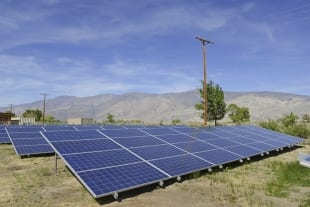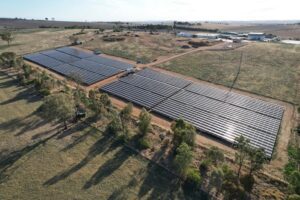
Tendril, the Boulder, Colo.-based software startup, rebooted its business last year with a shift to microtargeted energy savings products through its new Energy Services Management platform. Today, the company announced it’s expanding its product line with a customer acquisition and engagement solution for utilities getting into community solar.
The new end-to-end solution is designed to help utilities accelerate the development of community solar projects through enhanced customer targeting, personalized proposal generation and ongoing interaction.
Residential solar can be seen as a threat to utilities because it reduces electricity sales. But it doesn’t have to be that way, according to Tendril CEO Adrian Tuck. Utilities can leverage their access to consumers and low cost of capital to deliver solar in a way that benefits their bottom line and enhances overall customer engagement.
“We believe in the sharing economy, the Uber and Airbnb type of model of people not necessarily wanting to own all of their assets, but rent them and share them,” said Tuck. “This is a growth area, and community-based products and services will be natural places for utilities to go.”
According to a Department of Energy survey, nearly 50 percent of U.S. households can’t take advantage of rooftop solar because they don’t have a suitable roof, they live in an apartment, they’re renters, they don’t have a good enough credit score, or they simply don’t plan to own their home long enough to see their solar investment pay off. Community solar is billed as a way for households that can’t or don’t want to put solar panels on their roof to benefit from solar electricity.
An increasing number of utilities are pursuing community solar programs, either through their own programs or mandated ones. According to GTM Research, the U.S. community solar market reached a total installed capacity of 63 megawatts at the end of 2014, up from just 2 megawatts in 2010. Forecasts show an additional 400 megawatts coming on-line in the next two years alone.
Tendril believes its technology is key to making that opportunity a reality.
“The challenge with community solar is how to identify customers and do outreach to customers in ways that will excite them about the concept and get them to sign up,” said Tuck. “And then, once you’ve got them signed up, [you need to] provide an intimate experience for the customer so they can see their solar production just as if it was on top of their roof.”
Utilities’ community solar programs have struggled so far to achieve the personalized feel that helped make rooftop PV a huge success. According to Tuck, big data and analytics tools can help to significantly increase the success of utilities’ community solar programs. Tuck said Tendril is also working on a similar product to enable storage-as-a-service.
A “no-conflict” model that focuses on low-income families
The marketing piece of Tendril’s latest offering uses data from the company’s existing platform to target a state, town, ZIP code or individual home, and then runs queries on whether or not the people living there are candidates for community solar. The result is a very segmented list of people for service providers to contact.
Based on Tendril’s experience with other power programs, this strategy should achieve a signup rate that’s two or three times higher than what can be achieved by blanket-marketing a population.
While helping to home in on potential community solar customers, Tendril’s program can also determine which customers are good potential rooftop solar customers and flag them as households utilities shouldn’t target. With this insight, utilities can target their products and services at people who wouldn’t otherwise be solar PV users, said Tuck.
The idea that large, monopolistic utilities would take market share away from smaller, third-party solar developers is often used in the case against utility-owned residential solar. Tendril’s system theoretically resolves this conflict by allowing utilities to focus their efforts on customers that third-party providers can’t reach.
“Our advice to utility customers is to focus on marketing [community solar] to at-risk groups, focus on low-income families and really strengthen the case that utilities can bring a product to market that isn’t served by others in the space, so there’s no conflict there, and drive that model. And that seems to be resonating strongly with regulators and the customers we’re working with.”
The next element of Tendril’s offering is a landing page where potential customers answer a few questions, then get to see how much they would save from community solar in terms of money and environmental impact. The website factors in pricing information specific to each utility and each solar project, and allows customers to tailor the size of the system they want based on the results they want to see.
Once a household becomes a customer, Tendril’s platform allows them to monitor their solar energy production and consumption “just as if it was on your own home,” said Tuck. This information allows customers to find out exactly how much of their energy needs are being met by community solar, possibly compelling them to change their behavior to reduce overall energy use.
Attendees at the Edison Electric Institute’s Annual Convention taking place this week in New Orleans will get to see platform first-hand.
Like Tendril’s existing products, all of this goes on behind the scenes of a utility’s own platform. Tuck says Tendril will announce a number of different partnership models in the coming months in which utilities will either own, operate and rate-base community solar, or use a PPA to buy solar from a third party that owns the project, and then present it to customers as a utility option.
How big is the utility-owned community solar market?
There are currently 10 states that have enacted legislation that allows for community solar. Most of these programs mandate that utilities offer an incentive program and a compensation mechanism for power generated by community solar, which usually means the private sector steps in to build the projects.
This model has created some controversy in Minnesota, where the state’s largest utility, Xcel, is required to offer a community solar rewards program. Xcel recently announced plans to limit the size of community solar projects, which it says are becoming too big and costly for ratepayers. Developers have come out in strong opposition to the decision, claiming the move contradicts an earlier agreement. The Minnesota Public Utilities Commission is expected to make a final decision on the matter in the coming days.
Despite the challenges, the majority of community solar activity in the near term is expected to take place in states with third-party players. “It’s the markets where community solar is owned directly by private developers that have proven experience managing subscriber acquisition, and putting together attractive deals, that allow consumers to see a net savings on their monthly bills,” said Cory Honeyman, senior analyst at GTM Research.
However, in the 40 states that don’t have community solar requirements, utilities are starting to launch their own community solar programs. The question for Tendril is how big this market will be.
Many utilities are launching one-off community solar pilots. But the target market for an engagement platform like Tendril’s are utilities that are in community solar for the long haul. Those players have to be willing to navigate regulatory and legislative hurdles, and establish new business models in order to deploy community solar at scale. Finding those partners could prove to be a challenge.
But at the same time, Tendril doesn’t have much competition. The company has one of the first end-to-end community solar platforms in the business. As the market continues to grow, Tendril could benefit from this first-mover advantage.
“The Opowers and C3s of the world, they’re focused on the bulk of the energy market, utilities that are today focused on compliance, EPA mandates and cost-cutting,” said Tuck. “We differentiate ourselves by focusing on that smaller subset of utilities that are forward-looking and [asking], ‘How am I going to develop new products and revenue streams that I need for the future?’”
“Community solar is one example of this, and you should expect other things from us,” he added.
Source: Greentech Media. Reproduced with permission.








